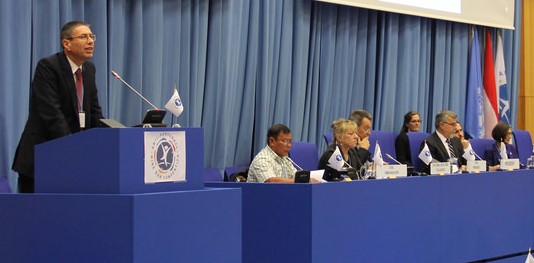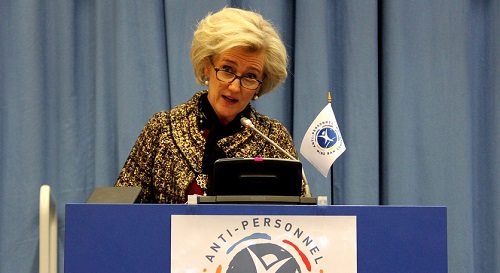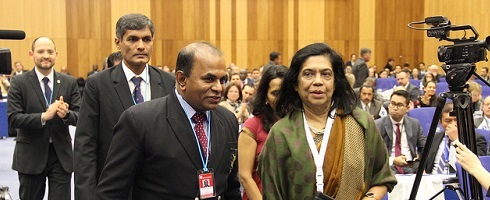| |
22.12.2017

** For information purposes only not an official record **
Vienna, Geneva – The Anti-Personnel Mine Ban Convention's Sixteenth Meeting of the States Parties (16MSP) concluded in Vienna, Austria, recording success in stockpile destruction, mine clearance, and universalization, and renewing its call against new use of anti-personnel mines by any actor anywhere.
The Conference expressed concern for the ever growing use of improvised landmines which has driven up the number of casualties to its highest levels since the 1990s, and called for sustained assistance to victims of these weapons.
The Conference also agreed that more sustained and targeted efforts in mine clearance were needed if the international community is to meet its 2025 mine-free ambition.
The Conference involved more than 520 participants representing over 100 delegations including 95 States (81 States Parties and 15 that are not yet part of the treaty), and 22 international and non-governmental organisations, many representing landmine survivors' interests.
The Meeting was chaired by H.E. Thomas Hajnoczi, Ambassador of Austria and Head of the Austrian Department for Disarmament. The Ambassador, who also led the work of the Convention for the past year, was a key figure of the process that in 1997 led to the adoption and signing of the treaty.
“It is really uplifting to think of the tens of thousands of lives that have been spared thanks to the Convention. When I compare the small number of States that set out to bring about the ban of anti-personnel mines together with the ICBL and ICRC 20 years ago, to where we stand today with 163 States Parties… that is change for a safer and better world. I am grateful that I could be part of it,” said the Ambassador who led the Austrian delegation during treaty negotiations.

To commemorate the anniversary, several key figures in the landmine movement attended the Meeting including the 1997 Nobel Peace Prize Co-Laureate and former ICBL Coordinator Jody Williams and ICRC President Peter Maurer. Both organisations were key in the process that concluded in the adoption and signing of the treaty. In addition, the Convention’s Special Envoys Princess Astrid of Belgium and Prince Mired of Jordan participated in the Meeting.

Princess Astrid opened a high level panel on the need to keep the promise made to landmine survivors.
Following the footsteps of the late Princess Diana of Wales, Prince Harry, through a video message, encouraged the Conference to action to meet its 2025 mine-free ambition.
Work of the Conference
Clearing of all mined areas - Algeria declared that after decades of work it had fulfilled its mine clearance obligation. Algeria went a step further destroying its entire stockpile which it had retained for training purposes.
- Thirty-one (31) States Parties are still in the process of clearing mined areas.
- One State Party, Afghanistan, has seen an increase in landmine contamination due to non-state actors’ use of improvised explosive devices.
- Among the States Parties that must still fulfil their mine clearance obligation are some of the most mine-affected in the world including Afghanistan, Angola, Bosnia and Herzegovina, Cambodia, Colombia, Iraq, Serbia, Thailand and Zimbabwe. Some of these countries will require additional technical and financial support if they are to meet the 2025 ambition set by the States Parties.
- The Conference expressed concern that Ukraine is now in a state of non-compliance and called on Ukraine to submit a request for extension of its mine clearance deadline as soon as possible.
Five States Parties requested and were granted extensions on their mine clearance deadlines under the following conditions, - Angola which joined in 2002, requested an 8-year extended deadline, the Conference agreed and provided a new deadline for 31 December 2025. Angola said it would require additional US$348.4 million to complete clearance and reported that in the last four years, there had been 361 new victims, including 158 children.
- Ecuador which joined in 1999, requested an additional eight years for mine clearance. The Conference granted Ecuador three additional years, until 2022 instead. Ecuador indicated that funding for humanitarian demining operations were interrupted in 2016, after a massive earthquake hit the country. Ecuador’s funding for mine clearance is US$20,937,735.
- Iraq which joined the Convention in 2007, requested that a 2028 extended deadline due to new contamination from improvised anti-personnel mines. The Conference granted Iraq’s request. Since 2008, Iraq has allotted a total of US$249,973,551 to its mine action activities. In total Iraq has demined 551,358,178 square metres. In the process, Iraq destroyed a total of 124,072 anti-personnel mines. Due to the current security situation and fight against the Daesh, Iraq has been unable to survey new contaminated areas.
- Thailand which joined in 1998, requested until October 2023 to clear 305 mined areas. The Conference agreed to provide Thailand until that date to address its mine contamination.
- Zimbabwe ratified the Convention in 1998. A heavily mine-affected country, Zimbabwe has requested various extensions due to financial reasons, and lack of knowledge of true mine contamination. The Conference agreed to extend the deadline until 31 December 2025 to address its remaining mined areas.
Destroying stockpiles - After missing its original deadline, Belarus indicated that it had fulfilled its obligation under the Convention destroying all its stocks of anti-personnel mines. Belarus said it had destroyed over 300,000 mines with TNT filling, and more than 3 million Soviet-era PFM-1 mines, which are extremely hazardous and pose serious technical difficulties to destroy. Belarus achieved this goal through a European Union-funded project.
- Greece has faced a unique challenge since 2014 when a deadly explosion at a Bulgarian destruction facility–where Greece’s stocks were being destroyed–halted Greece's efforts. Both countries are in talks to determine safe transfer of these weapons for destruction.
- Ukraine faces a particular challenge in meeting its deadline, as most of the stock it has to destroy is of the PFM-1 type -- mines which are extremely hazardous and pose serious technical difficulties to destroy.
Universal adoption of the Convention - Sri Lanka acceeded the Convention just days before the meeting and was welcomed by the Conference as the newest State Party. Their accession is important as it will encourage others in a region with low adherence. The Sri Lanka delegation presented the Conference with a copy of their instrument of accession.

- On the last day of the Conference, 21 December, the State of Palestine indicated that it would accede to the Convention.
- 163 States are party to the Convention including the majority of States that have been affected by landmines; all members of the European Union; every State in Sub-Saharan Africa, and every State in the Americas except for Cuba and the United States.
- 34 States have not yet ratified or acceded to the Convention. Combined six of them – China, India, the Republic of Korea, Pakistan, Russia and the United States – may hold tens of millions of stockpiled antipersonnel mines. All of these but Korea and Russia attended the Convention as Observers and have expressed agreement with the Convention’s humanitarian objectives.
- After reports of landmine use, Myanmar addressed the Conference saying it did not engage.
Next Presidency
The conference elected Afghanistan as the next presidency of the Convention. H.E. Suraya Dalil, Ambassador of Afghanistan to Switzerland and the United Nations in Geneva was elected to chair the Convention's Seventeenth Meeting of the States Parties (17MSP) from 26-30 November 2018 at the UN in Geneva. Ambassador Dalil will also lead a Pledging Conference on Implementation of the Convention and the Meeting of the Standing Committees in mid-2018.
For more information contact the Convention's Implementation Support Unit: isu@apminebanconvention.org.
|





